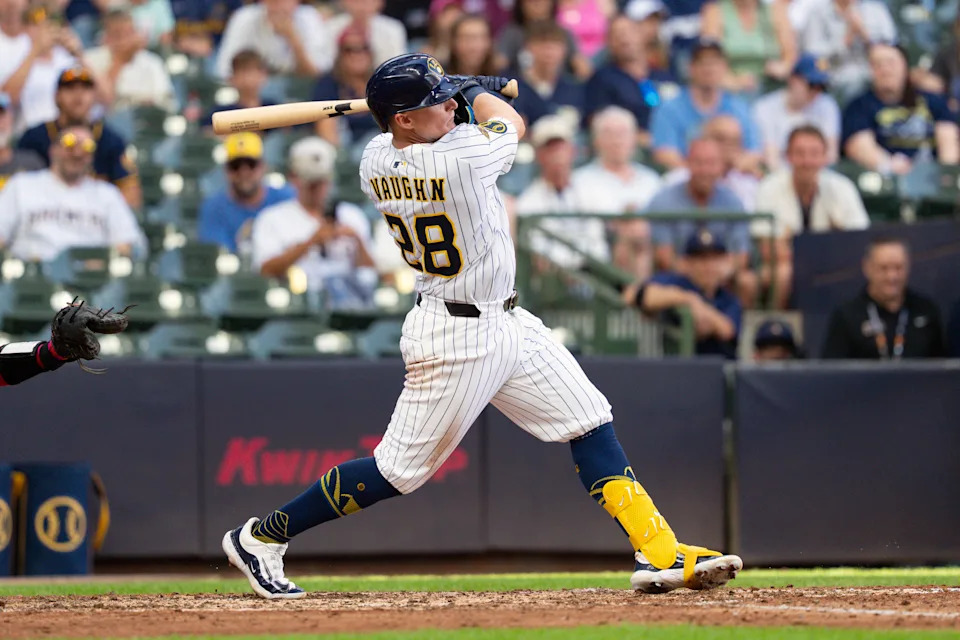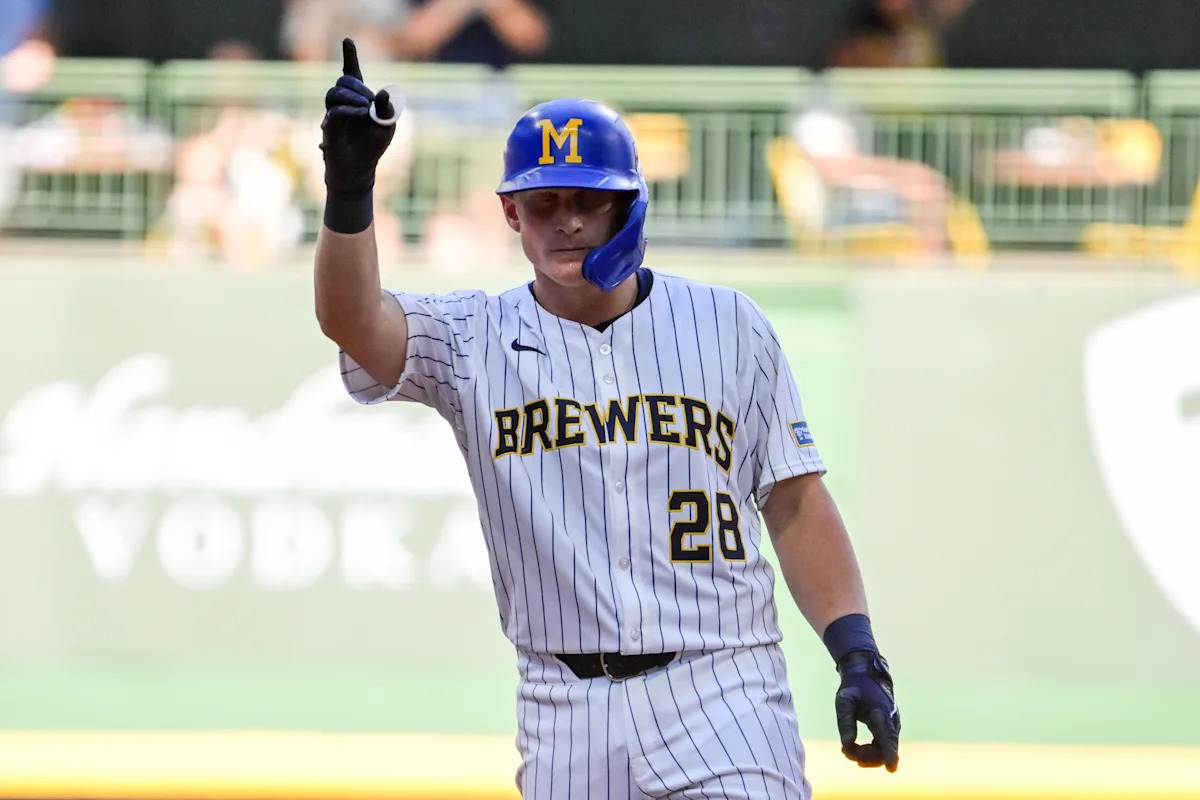Milwaukee Brewers manager Pat Murphy spoke bluntly when asked about his club’s out-of-nowhere breakout star Andrew Vaughn.
“This,” he assured assembled members of the media in Washington on Aug. 2, “is real.”
Advertisement
With each passing day, game and long ball, Murphy’s claim looks more and more correct.
After an underwhelming, tumultuous four-plus-year stint with the Chicago White Sox, Vaughn was dealt to Milwaukee in mid-June for impending free-agent pitcher Aaron Civale. Civale had been crowded out of a talented Brewers rotation and requested a trade. Vaughn, once hailed as the future of the White Sox, had been a bottom-five hitter in 2025, earning him a demotion to Triple-A. But Milwaukee’s agile front office saw a buy-low opportunity.
Since joining the Brewers’ big league club on July 7, Vaughn has been the National League’s best bat. The 27-year-old first baseman has slugged seven home runs across 90 plate appearances, with a sparkling 1.146 OPS. He has chased less, allowing him more opportunities to get his best swing off and do damage in advantage counts. As a result, his batted ball numbers have improved. He looks rejuvenated, reinvented, finally making the most of the talent that made him the No. 3 overall pick in the 2019 Draft behind Adley Rutschman and Bobby Witt Jr.
[Join or create a Yahoo Fantasy Football league for the 2025 NFL season]
He has given Milwaukee’s productive, contact-oriented offense a much-appreciated injection of power, becoming a cult hero along the way. On Aug. 26, the first 10,000 Brewer fans at American Family Field will receive a “King Vaughn” giveaway T-shirt.
Advertisement
In a month’s time, Vaughn has gone from afterthought to lynchpin. It has been a remarkable turnaround, the quintessential change of scenery story.
“Putting guys in environments and situations that can allow them to express themselves, and they can handle it, is the difference.” Murphy explained. “And I think that us, giving Vaughn the chance, everything lining up, [Rhys] Hoskins going down, him getting that chance and being back in the big leagues in a new environment has kind of helped. I don’t think it’s too much more than that.”
When the White Sox demoted Vaughn to Triple-A on May 23, he had an abysmal .189/.218/.314. batting line across 193 plate appearances. Over that span, according to FanGraphs, Vaughn was worth -1.4 Wins Above Replacement, making him the single least valuable player in all of baseball. That performance, or lack thereof, was a notable departure from his previous four big league seasons.
After a historically great college career at Cal, Vaughn was hyped as a future All-Star, the type of slugger who intimidates pitchers and carries lineups. But upon debuting in 2021, Vaughn was decidedly mediocre, inoffensively average. The White Sox unsuccessfully tried him in an outfield corner, where he was a defensive catastrophe. And so, from 2021 to 2024 Vaughn was essentially a houseplant, a capable, yet unspectacular big-league hitter.
Advertisement
Then, this year, the wheels fell off. A former White Sox minor leaguer questioned Vaughn’s work ethic. Beneath the surface, there were encouraging signs in the batted ball data, but Vaughn’s overall body of work had become too unsavory to ignore.
“At this point, though, we can’t just rely on the expected numbers,” White Sox general manager Chris Getz told reporters the day after demoting Vaughn. “The level of production that we need to see out of him and that position needs to be better. There’s some physical adjustments that can be made, and we’re going to dive into that.”
Two weeks later, Vaughn was a Brewer.
It was a change in scenery that also brought a change in philosophy. As Getz mentioned, the White Sox were most concerned with Vaughn’s hitting mechanics. The Brewers, however, unspooled a completely different strategy, one focused primarily on Vaughn’s approach at the plate.

Andrew Vaughn is enjoying his new home in Milwaukee. (Jeff Hanisch-Imagn Images)
(IMAGN IMAGES via Reuters Connect / Reuters)
“He’s found the freedom to compete to bring out his best self,” said Murphy. “And part of that best self is in order to be effective I got to demand what the pitcher does. I have to, I have to be the one that dictates what I swing at. So his readiness, pitch to pitch, and his ability to lay off some things, it’s been very good.”
Advertisement
In Chicago, Vaughn was chasing 34 percent of the time, a 12th percentile mark. As a Brewer, that number has plummeted to 24 percent, an 80th percentile mark. Laying off pitches outside the zone has put Vaughn in better counts, enabling more damage.
The change in environment, too, has undoubtedly played a positive role. This Brewers team is a ragtag circus of discarded parts, playing loose and free under one of the game’s most respected coaching staffs. The White Sox have lost more games over the past two seasons than any other club, a reality that can foster an unhelpful, unmotivating environment.
Vaughn’s power output, if sustained, could potentially reshape the playoff race. Milwaukee, the first team to tally 70 wins, entered play Friday four games up on the Chicago Cubs. That advantage comes despite a substantial home run gap between the two clubs. Only three Brewers have reached double-digit home runs, Christian Yelich and the currently IL-ed Hoskins and Jackson Chourio. Vaughn, despite playing in only 22 games, needs just three more homers to reach that mark.
Advertisement
Vaughn’s ascension to a vital contributor is even more improbable considering the Brewers called upon him only after an injury to Hoskins necessitated a promotion from Triple-A. Not even the team that helped resuscitate his career saw this coming. Vaughn won’t outslug Aaron Judge for much longer, but even if he doesn’t go yard again, he’s already delivered more for Milwaukee than anybody could have expected.

